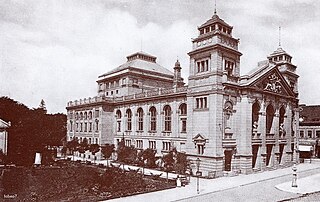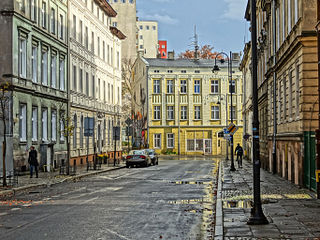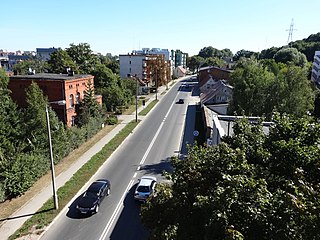Jadwiga Szopieraj | |
|---|---|
| Born | 1908 Leszczyce, |
| Died | 1975 |
| Nationality | Polish |
| Known for | Pictures |
| Partner | Piotr Szopieraj |
Jadwiga Szopieraj (1908-1975) was a Polish woman who pioneered professional photography during the interwar in Bydgoszcz, Poland. [1]
Jadwiga Szopieraj | |
|---|---|
| Born | 1908 Leszczyce, |
| Died | 1975 |
| Nationality | Polish |
| Known for | Pictures |
| Partner | Piotr Szopieraj |
Jadwiga Szopieraj (1908-1975) was a Polish woman who pioneered professional photography during the interwar in Bydgoszcz, Poland. [1]
Jadwiga Krygier was born in Leszczyce, a small town 8 km south west of Inowrocław. As a teenager, she left her hometown to move to Bydgoszcz, to a relative's house.
Jadwiga apprenticed with the master of photography Tytus Piechocki. The latter is known to have taken pictures of the First City Council in Bydgoszcz (1920-1921) and a portrait of Polish actress Pola Negri. [2]
When Piechocki founded the Bydgoszcz Guild of Photographers (Polish : Cech Fotografów w Bydgoszczy) in 1937, Jadwiga was one of the few women member of the 37-people strong association. [3] Over time, she took over Tytus studio.
Jadwiga married Piotr Szopieraj, a tailor by trade. They bought in the 1920s a photography studio and a flat at 8 Świętojańska street (the villa is no more existent) from the Salewskis'. The premises (house and studio) dated back to the end of the 19th century, built with a glass roof on a design by local photographer Carl Weiss. [3] He ran here his workshop for 20 years; the place was then bought by the Salewski family who rented it to other photographers. [3]
The Salewski couple soon divorced, but kept living in separate flats, next to each other in the same tenement: he was at number one, she at number two, where she also had a photography studio. In those times, the Szopieraj must have lived somewhere nearby as portraits of Jadwiga and her husband posing in Zalewska's studio have been found. [4]
Jadwiga and Piotr had four children, a boy and three girls. They lost their youngest daughter in 1937. [4]
During World War II, Jadwiga had to close her studio since Germans did not allow Poles to work for money. However, it is known that she was still taking photos covertly. The Nazis took her husband and her son as forced labor to work on ditches near Grudziądz in 1944. [3] In February 1945, the men returning to Bydgoszcz were stopped and shot down by the Red Army in Janowo, near Bydgoszcz. [4] Lastly, she lost her second daughter, 7-year-old Krysia, in 1946. [4] Szopieraj made post-mortem pictures of all her daughters: Terenia (1938), Krysia (1946) and Lidka (1951). [3]
After the war, Jadwiga Szopieraj operated her studio on Świętojańska Street until the 1960s. She lived there until her demise in 1975 and her surviving daughter stayed at the same address till 2000, when the family tenement was razed down.
Jadwiga Szopieraj was the main subject of the book "Profession: Photographer" (Polish : Zawód: Fotografistka), by Katarzyna Gębarowska and Małgorzata Czyńska. Their work was awarded the "Łuczniczki Arrow" (Polish : Strzałą Łuczniczki) [5] at the "Bydgoszcz Literary Award 2019" (editorial category) and won as well a distinction at the 60th national "Competition of the Polish Society of Book Publishers" (Polish : Polskie Towarzystwo Wydawców Książek) in 2019 (category:"Most Beautiful Books of the Year"). [6]
Her photographic works were presented at the exhibition Eros and Thanatos. Pioneers of professional photography from Bydgoszcz 1888–1945 (Polish : Eros i Tanatos. Bydgoskie pionierki fotografii zawodowej 1888–1945), housed by the Regional Museum of Bydgoszcz from 12 November to 8 December 2019. [7]

Jadwiga Szopieraj is the topic of a mural created by the artist SEPC in 2019 during the fifth edition of the Vintage Photo Festival. [8]
The mural covers the wall of the tenement at 68 Pomorska street where seats the Fundacjia Fotografistka, on Świętojańska Street, near the ancient studio of the photographer. [9] True to his technique, SEPC's painting is realized as a negative picture. [10] The real image is visible only after "reversing" the colors to positive.
SERPC is the pseudonym of a Colombian painter, Juan Sebastian Jimenez. [11] For Jadwiga's mural, the artist used as a reference an archival photo found by Katarzyna Gębarowska, a researcher and director of the Vintage Photo Festival. [12] The photo was originally hand-colored by Jadwiga herself, an habit she kept even after WWII. [13]

BELMA is a Polish defence company located in Białe Błota, in the vicinity of Bydgoszcz. It is one of the oldest industrial plants in Poland. Belma's business began in 1868 as a locksmith company. Its primary responsibility today is the production and design of land mines for the Polish Army. BELMA is the only manufacturer of anti-tank mines in Poland.

Tenement at Gdańska street 67 is a habitation house located at 67 Gdańska Street, in Bydgoszcz. It displays early forms of Modern architecture, with elements of Art Nouveau.

Pomorska Street is an important street in downtown Bydgoszcz.

The Municipal Theatre of Bydgoszcz is a former theatre building which stood in Bydgoszcz, Poland from 1896 to 1946.

Piotra Skargi street is a historical street of downtown Bydgoszcz.

Mikołaja Reja Street is a historical street of downtown Bydgoszcz.

Królowej Jadwigi Street is a street located in Bydgoszcz, Poland. Many of its buildings are either registered on Kuyavian-Pomeranian Voivodeship heritage list, or part of Bydgoszcz local history.

Przyrzecze street is a street located in the old town district of Bydgoszcz, Poland. Many of its buildings are part of Bydgoszcz local history. Due to the proximity of the river, its townhouses represent a picturesque urban complex.
Rudolf Kern was an important designer and builder in Bydgoszcz, at the end of the Prussian period of the city. Most his works have been realized between 1903 and 1914. His artistic style relates to Art Nouveau and Modernism.

Obrońców Bydgoszczy street is located in downtown district, in Bydgoszcz, Poland. Many of the buildings along this axis are either registered on the Kuyavian-Pomeranian Voivodeship heritage list, or part of a historical ensemble of Eclectic and Art Nouveau architecture in the city.

Bydgoszcz Old Market square is an oblong place, situated in the old town district of the city of Bydgoszcz. The City Hall flanks one of its side, and nearby is located St. Martin and St. Nicholas Cathedral.

Świętego Floriana Street is located in the downtown district of Bydgoszcz, Poland. Despite its short length of roughly 200 metres (660 ft), it features many notable buildings in a variety of architectural styles, including Eclectic, Art Nouveau and early modernist. The street is named after Saint Florian.

Garbary street is located in the Okole district of Bydgoszcz city, Poland. Its development occurred during the second half of the 19th century and today it displays several buildings listed on the Kuyavian-Pomeranian Voivodeship Heritage list, with a variety of architectural styles, from eclectic to early modernist. The area also nurtured a series of local successful factories, under the Prussian and the Polish periods.

Toruńska Street is the longest and one of the most ancient street in Bydgoszcz, Poland.
The Vintage Photo Festival – International Festival of Analog Photography Enthusiasts is an annual cultural even organized in Bydgoszcz by the Fotografistka Foundation... It was created in 2015 out of passion for analog photography and the belief that old techniques in photography were experiencing a renaissance. Despite great revolution and evolution in digital photography, the return or even the rebirth of so-called traditional photography is visible. Film cameras are back in use, which can be proven by photographic film manufacturers such as Kodak who in recent years has got back to manufacturing several types of negative film which were taken off the market in the past. As a result, younger and younger creators are using analog photography as their medium of expression.

Located in the Babia Wieś District, the Babia Wieś Street is a half-kilometre-long alley extending along the Brda River, close to downtown Bydgoszcz in Kuyavian-Pomeranian, Poland. The street runs between Toruńska Street and the Brda River, running parallel to the East-West direction. It has a curved shape, and crosses Toruńska Street at both tips.

The Foton factory in Bydgoszcz, Poland, was the first Polish producer of photosensitive material on photographic paper. It was active from 1926 to 2007.

Jadwiga Irena Golcz (1866–1936) was a Polish photographer, one of the pioneering women of the medium in Poland. Golcz owned a studio in Warsaw and took portraits of leading Polish artists.

Tadeusza Kościuszki street is a 600 metres (2,000 ft) long avenue in the northern part of Bydgoszcz. Its houses display various various architectural styles. The path is a witness of the end-of-19th-century industrial activity of the city.

The Jaz Czersko Polskie is a roller dam located in the area of the mouth of the Brda river to the Vistula river in Bydgoszcz. Belonging to the district of Czersko Polskie, it is the initial stage of the 294.3 kilometres (182.9 mi) long inland navigation route Vistula-Oder waterway, connecting the rivers Vistula and Oder.